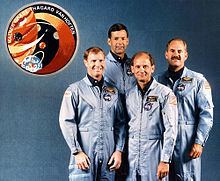Mission type Spacecraft deployment Launch site Kennedy LC-39A Inclination 34.3° Landing date 24 May 1986 | Landing site Kennedy Runway 33 Dates 20 May 1986 – 24 May 1986 Crew size 4 | |
 | ||
Mission duration 4 days, 2 hours, 45 minutes, 20 seconds planned Launch date 20 May 1986, 20:21:00 UTCNever launched Members David M. Walker, Ronald J. Grabe, Norman Thagard, James van Hoften | ||
STS-61-G was a United States Space Shuttle mission planned to launch on May 20, 1986, using Atlantis. The main objective of this mission was to launch the Galileo spacecraft toward Jupiter using the Centaur-G upper stage. It was canceled after the Challenger disaster.
Crew notes
John M. Fabian was scheduled to fly as Mission Specialist 1 on his third trip to space, but due to concerns and stress about the Centaur-G worst-case-scenarios, he resigned from this mission. His replacement was Norman E. Thagard. Most of the crew sans van Hoften flew on STS-30 in May 1989, with Mary Cleave taking the place of van Hoften and the addition of rookie Mark Lee. Galileo was launched on STS-34 in October 1989, using the Inertial Upper Stage booster instead of the Centaur-G (which was canceled in 1986).
